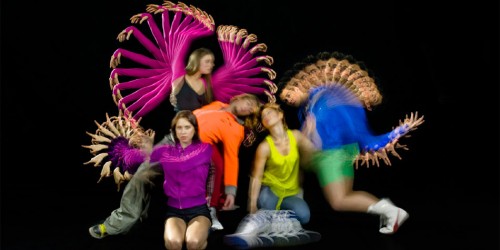Work those neurons: ADT’s Proximity
Proximity comes from the mind of Australian Dance Theatre’s Garry Stewart, with choreography that’s developed with his dancers and created to work with the live video manipulation by artist and engineer Thomas Pachoud. Taking its inspiration from theories in neuroscience – such as that the neurological maps stored in our brains incorporate the physical attributes of what we touch into our perception of ourselves – this contemporary dance offering is a chance to work your own synapses.

I had a variety of reasons for being curious about Proximity. The attention-grabbing poster made me recall that of a past ADT show, Held from 2004, that featured projected images from New York dance photographer Lois Greenfield behind the action. Building on the heritage of Held by utilising updated technology, and continuing the consideration of selfhood seen in Be Your Self, Proximity offered the tantalizing promise of how video effects would enhance my experience of movement: “the body is metamorphosed and freed from the limitations of its established relationships to physics and biology”.
Proximity has three sections, aiming to explore seeing and perception, experiences of selfhood, and how the brain adapts our perception of ourself in space to include objects we interact with. The latter section is most described in the programme, and from my experience, the most comprehensible. In this, Proximity also illustrates an idea from educational theory, the zone of proximal development, that proposes that a student with a particular knowledge cannot succeed in tasks beyond that knowledge without assistance.
As someone who hasn’t seen much contemporary dance, I found myself often lacking the knowledge to derive artistic satisfaction from the piece. Where my experience overlapped with the style of a particular sequence, pockets of meaning were easier to find. I particularly enjoyed a sequence drawing on martial arts, accompanied by suitable Eastern woodwind tones of Huey Benjamin’s composition. The dancers synchronised movements recalled kata – prearranged forms used by samurai in feudal Japan and still used in martial arts training today – designed to cultivate a state of relaxed readiness where the brain is trained to respond to stimulus faster than conscious thought.
As for the video effects, I found some of these somewhat superficial, even distracting. They were most stimulating when they enhanced the action. The most effective of these for me was when the projected image showed force beams between dancers, with lines evolving as postures changed. I found this quite an effective digital visualisation of the mental processing of our surroundings outlined in the programme.
Contemporary dance has its own language, so maybe Proximity isn’t the best place for the novice to expand a limited vocabulary. Despite my own incomplete understanding of the piece, I have to admire the vigorous commitment of ADT to pursuing and developing their art.
